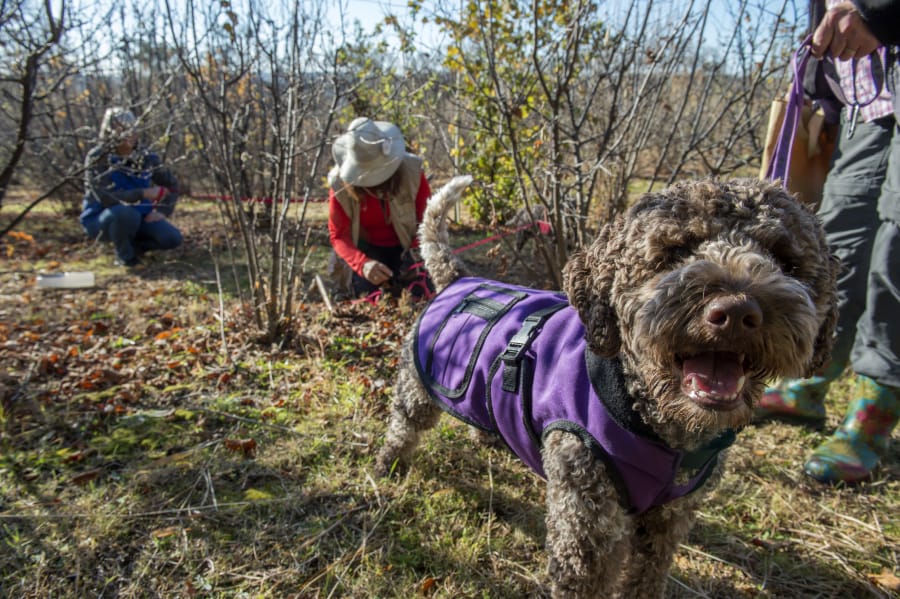PLACERVILLE, Calif. — Mila smells the aroma of buried treasure in a field of hazelnut trees north of Placerville, then paws at the ground, indicating to Staci O’Toole that deliciousness is hiding beneath the soil.
Mila is searching for one of the most expensive culinary delights — truffles. Known as the “Truffle Huntress,” Mila is a Lagotto Romagnolo dog specially trained to seek the tuberous fungi that grow alongside the roots of hazelnut and oak trees.
Last month, Mila and four other truffle-hunting dogs searched for the luxury fungi in O’Toole’s truffle orchards — fields of cork oaks and hazelnut trees whose roots were dipped in truffle spores before being planted. Looking out across the rows of trees, the truffles are impossible to spot. The black nodules grow underground.
O’Toole’s companions for the hunt also own developing truffle orchards: Fran and Robin Angerer and their son Seth in Geyserville, and Jim and Karen Passafaro in Santa Rosa. The group met years ago at the Oregon Truffle Festival and have since formed an association of about 19 West Coast operations that meet regularly to share knowledge, train their dogs and hunt for truffles.
Since growing truffles is arduous and time-consuming, most are waiting for their inaugural harvest. But small amounts of truffles recently harvested in Sonoma and Napa counties give them hope that the local scene will blossom soon. They’re betting that the region’s farm-to-fork-conscious chefs will pay big to offer locally sourced truffle dishes.
O’Toole caught the truffle bug seven years ago when she started looking for a new dog. She wanted something with a Labrador retriever personality, but smaller and with less shedding. Lagotto Romagnolo was one of two dog breeds that fit her criteria and she was sold when she saw they hunted truffles.
Paired with a dream job wish list she compiled with her friends — something with dogs, hiking, food and wine — getting and training a professional truffle dog seemed like a no-brainer.
“It’s kind of strange how you put stuff out there into the universe and then before you know it, seven years later, we’re truffle hunters,” she said. “Owning a truffle orchard with a ranch. It gives me goose bumps still when I think about it, just how it happened.”
When she starts getting reliable harvests, she plans to turn her orchard and ranch home into a destination for truffle hunting, cooking and Northern California recreation.
Despite the commonly held notion that truffles are sought by pigs, dogs like Mila have replaced swine as the primary truffle-seekers because pigs don’t like to give up a truffle once they’ve unearthed one. In Italy, pigs are banned from truffle-hunting grounds because they damage the terrain.
Mila has been training since birth for this task as her breeder put truffle oil on her mother’s teats when she nursed. She found her first truffle at 12 weeks, in an Oregon orchard.
The Truffle Huntress didn’t find any truffles in O’Toole’s orchard on the December hunt, which O’Toole thought might happen. It’s the beginning of the season and her orchard is just closing in on an age when she can start to expect the knobby fungus. Mila did find some areas that smelled enough like truffles to mark the spot by pawing the ground.
O’Toole then grabbed a spade and dug through the dirt.
You know you’ve got a truffle “when you open up a hole and the smell hits you in the face,” she said. She brought the soil to her face to sniff for the unique musky scent.
A pound of black Perigord truffles, the type planted by O’Toole and the other truffle hunters, can fetch between $600 and $900.
A truffle orchard develops slowly as the inoculated roots of the trees take hold. It takes five to 10 years to begin producing notable harvests.



